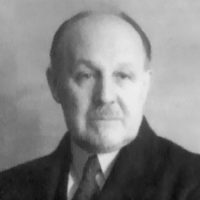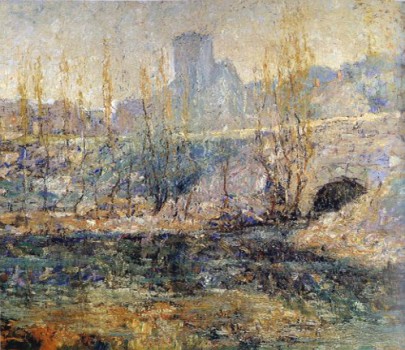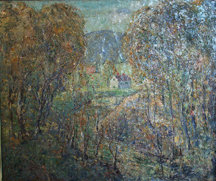

The member of the Ash Can School most closely associated with impressionism, characterized as employing a “palette of crushed jewels,” was the son of Dr. Archibald Lawson and Annie Mitchell. Lawson once told a group at Mouquin’s that his first “work of art” was a tattoo of an anchor and a star, on his own arm, for which he was given a spanking (Perlman, 1979, p. 105). His art studies began in 1888 at the Kansas City Art Institute. Two years later he was in the *Art Students League in New York, learning from *John H. Twachtman, who urged him to transfer to his art school at *Cos Cob. There, Lawson came under the influence of *J. Alden Weir. Following the typical course of American artists, Lawson enrolled in the *Académie Julian in Paris in 1893, under *Jean-Paul Laurens and *Benjamin Constant.
While in Moret-sur-Loing, near Fontainebleau, Lawson underwent a direct influence of *Alfred Sisley’s style. Lawson stated that he actually met Sisley, who was in poverty with only several more years to live. In the sale catalogue upon his death, Sisley was described as “irritable . . . and . . . full of suspicions [during his final years]. Little by little all joy left his days, except for the joy of painting, which never abandoned him” (quoted by Rewald, 1946-A, p. 576). Lawson’s Church at Moret-sur-Loing (Private collection) might be compared to Sisley’s rendering of the church, in the Rouen Museum. Lawson was sharing a studio in Paris with Somerset Maugham at this time; it is believed that Maugham’s character of Frederick Lawson in Of Human Bondage (1915) was drawn from the real Ernest Lawson.
After returning to the States in the summer of 1894, Lawson exhibited three canvases at the *Pennsylvania Academy of the Fine Arts, and married Ella Holman, one of his art teachers in Kansas City: their honeymoon was spent in France, where Lawson did more views of Moret-sur-Loing. The Lawsons’ marriage resembled today’s long-distance relationships: while Ernest taught for a while in Columbus, Georgia, Mrs. Lawson taught classes in Ashville, North Carolina and they met up at their northern home in Washington Heights, New York. 1898 marked the beginning of Lawson’s “Harlem River” period; during that year, Lawson exhibited two works in the Carnegie International and in 1899 he showed five canvases at the Pennsylvania Academy. Between 1905 and his death, Lawson submitted and exhibited works regularly at the *National Academy of Design’s annuals.
Lawson’s Gray Day and A Winter Landscape won him a silver medal at the *St. Louis Universal Exposition in 1904. Later that year, the Lawsons moved to Greenwich Village and joined the MacDougall Alley coterie, which by 1907, would include Gertrude Vanderbilt Whitney, James Earle Fraser, Daniel Chester French, *Charles Hawthorne, and others. Lawson met *Dewing, *Henri, and *Glackens. The River in Winter by Lawson won the Pennsylvania Academy’s Jennie Sesnan Gold Medal in 1907. At that time, *James Gibbons Huneker (1907-J) became one of Lawson’s earliest champions. He praised Lawson’s “direct, *virile vision” and recommended is art to viewers with “strong stomachs” who want to see “real, not fictitious life.” Although Lawson’s nomination to the National Academy had been rejected, he did become an Associate in 1908, and won the First Hallgarten Prize, with Ice on the Hudson. In that year he painted Portrait of May Wilson Preston (formerly in the Coffee House Club).
At William Macbeth’s show in February 1908 of the Eight, Lawson sold one painting, Winter on the River (or Floating Ice) to Gertrude Whitney (still in the Whitney Museum). Also in Macbeth’s show were Swimming Hole, Abandoned Farm (National Museum of American Art), and Early Summer (Columbus Museum of Art, Columbus, Ohio). The Boston Evening Transcript (5 February 1908) found Floating Ice to be “provocative” with its “willful lack of design.” Huneker (1908-F) called Lawson a “sensitive pantheist” in his review for the New York Sun. In April 1910, Lawson took part in the organization of the *Exhibition of Independent Artists, which was held in a loft building on 35th Street. The show did not include the modernists under *Stieglitz’s wing, and Walter Pach told Sloan that Stieglitz was “hot under the collar about our show” (Sloan, 1965, p. 402). On 6 November 1910, Huneker wrote on Lawson’s Coney Island pictures, noting that “the vibrating color hatches and patches of this artist never suggest the niggling mannerism of so many impressionists.”
Lawson sold several works to *Dr. Albert Barnes in 1912. Barnes (1925, p. 345) wrote that Lawson contributed to innovations to the history of impressionism, as far as technique, however, Barnes admired how Lawson successfully rendered the variety of natural phenomena. Showing his French bias, Barnes stated “He achieves the natural lyric quality of landscape, but neither so deeply nor so delicately as the great French impressionists.” Lawson exhibited three landscapes in the *Armory Show (cat. nos. 904-905, 1095): Cloud Shadows, Weeds and Willow Trees, and Upper Manhattan. In 1915, Lawson had three works on display at the *Panama-Pacific International Exhibition, where he won a gold medal: Hills at Inwood (Columbus Museum of Art), Beginning of Winter, and Hudson River and Palisades. The latter is illustrated in Art in California (1916, pl. 111).
A year later, Lawson was awarded the W.A. Clark Silver Medal at the *Corcoran Gallery’s biennial, for his outstanding Boathouse, Winter, Harlem River, which became part of the Corcoran’s permanent collection. The prize enabled the Lawsons to travel to Segovia, Spain, where they met up with *Max Kuehne (see Boone, 1998-99). Presumably, all of Lawson’s views of places in Spain were executed in that year. *Duncan Phillips (1917), “more than ever impressed” with these freshly executed canvases, mentioned that these works were finished in Lawson’s MacDougal Alley studio. In Phillips’s words, the *picturesque scenes were transcended and given “a vigorously-phrased American” touch. Price (1924-A) detected “vibrant . . . more positive and definite” color in the monumental Near Segovia. Lawson’s daughter verified that the Lawson family lived near a castle in Segovia, in a house with a magnificent view of the castle and the cathedral.
Back in New York in early 1917, Lawson was elected full member of the National Academy, and received the Inness Gold Medal. The Spanish paintings were exhibited at the Daniel Gallery, with very few sales. The Addison Gallery of American Art’s Morning Light, Connecticut River Valley was painted in 1919. At the Pennsylvania Academy in the 1920 annual exhibition, Lawson won the Temple Gold Medal for Ice-Bound Falls (Art Institute of Chicago). In contrast to a fairly successful career as an artist, Lawson’s private life was distressing. Lawson and his wife separated – at that time, there were two daughters, ages twenty-five and twenty-three. While Mrs. Lawson went away to France with the daughters and turned to metaphysical philosophy, Lawson increased his drinking.
On the bright side, Lawson won a gold medal for Vanishing Mist at the 1921 Carnegie International, the same painting that had won him the Altman Prize earlier that year at the National Academy. The painting, which ended up in the Carnegie Institute’s collections, was deemed “one of the greatest American landscapes” by Guy Pène du Bois (1932, p. 10). It is one of Lawson’s most “grand” achievements, a magnificent vista of receding parallel planes, unified by his quintessential heavy impasto. The solidity of the landscape’s structure made one writer recall *Cézanne: even the clouds are monumental (Strazdes, et al, 1992, p. 313). The lonely leafless tree in the foreground adds a rather romantic touch, bringing to mind works by Thomas Cole, or Washington Allston’s Elijah Fed by the Ravens (Museum of Fine Arts, Boston), of 1818.
In 1924, Lawson revisited his birthplace, Halifax, as well as Newfoundland. Two years later he moved to Kansas City for a teaching position at the Art Institute; after a year, he went further west to teach at the Broadmoor Art Academy in Colorado Springs during the summers of 1927 to 1930. *Robert Reid, who had been teaching there since 1920, left Broadmoor the year of Lawson’s arrival. The Colorado landscape was almost too overwhelming; as Lawson explained to Guy Pène du Bois (1932, pp. 10-11), “I couldn’t feel the place; that stuff, it was too bleak . . . forbidding.” Royal Gorge, Colorado (Santa Barbara Museum of Art), dated 1928, is an example of his bold, pure landscapes from this area. His painting Hills in Winter won Lawson another Altman Prize, also in 1928. Unfortunately, his exhibition in Colorado Springs in that year was financially unsuccessful. To the Museum of Modern Art’s 1929 show, “Nineteen Living Americans,” Lawson contributed The White Horse.
One of Lawson’s happiest years was 1930. First, he won the Saltus Gold Medal at the National Academy for a large 40 x 50 oil, Gold Mining, Cripple Creek (National Museum of American Art), which was purchased through the Ranger Fund. It features a richly textured mass of hills built of intersecting diagonals, with an extremely high horizon line. Thanks to the Saltus Gold Medal, Lawson could travel to France to visit his daughter and two grandchildren. His youngest daughter had died in 1926 on a trip to Egypt. The first Lawson retrospective, including fifty-two works, was also in 1930. Price (1930) wrote a brief essay and illustrated every canvas, providing a valuable visual document of Lawson’s work up to that year, which was an artistic statement of great integrity.
In the following years, Lawson kept an active exhibition schedule, began a teaching job in Hartford, Connecticut, and visited Florida annually; he moved to Coral Gables in 1936. Like most artists, Lawson found it difficult to sell his works, during the decade of the Depression, however, there were a few bright moments. He won the Samuel T. Shaw Prize at the *Salmagundi Club, and both the *Metropolitan Museum and the Pennsylvania Academy purchased one of his landscapes. Although this lifted his spirits, Lawson was disheartened by the death of his friend *William Glackens, in 1938. An old photograph from 1932 shows the two still dapper painters, then both in Coral Gables, walking with canes, but it bespeaks their adventurous glory days in Greenwich Village. Lawson was stunned by his friend’s sudden death, and wrote, “I think I liked him better than any man I knew and it is a blow to me. . . . He was the best of his kind both as a man and as an artist” (Lawson to Edith Glackens, in Glackens, 1957, p. 128).
Lawson completed a mural in the Short Hills, New Jersey Post Office in the fall of 1939 (destroyed in 1963). On 18 December, his body was found on a Miami beach. Rumors of suicide spread, despite no evidence to indicate such an end. A painting on his easel was still wet and there was no suicide note (Berry-Hill and Berry-Hill, 1968, p. 60). Lawson’s champion, F. Newlin Price, dismayed upon the painter’s death, declared, “The arts are truly dead. Mars is living and Eros dying.” Price would live on until 1963, witnessing the tempestuous succession of American art movements – so far removed from the decorative naturalism of Ernest Lawson.
While Lawson’s status as an “American Impressionist” cannot be denied, it must be qualified. His *subject matter: industrial areas along the Hudson River, excavation sites, massive iron bridges, docks and fishing shacks, and unsightly urban areas, including the city dump, justify Lawson being grouped with the Ash Can School. Moreover, his interest in highly structured compositions, thought to reflect the widespread influence of Cézanne, makes Lawson more of a *post-impressionist. One might also compare the palette knife technique of an American post-impressionist like *Helen Hamilton. The fact that Lawson helped to organize the Armory Show and that he is represented in the Museum of Modern Art should suggest how much he supported progressivism in art. On the other hand, even his latest works are still tied to the impressionist aesthetic.
Perhaps the most genteel member of Henri’s “black gang,” along with *Prendergast, Lawson remained an American naturalist, who had no interest in the issues that excited Duchamp, Kandinsky, Picasso or Hans Hofmann. As Guy Pène du Bois calmly explained (1932, p. 13), Lawson “still likes trees and hills and water and houses. . . . ” He was an “impressionist” who loved the different aspects of nature in the various seasons, and he did, in fact, render his spontaneous impression of a fleeting moment. Yet his art was far removed from the Boston school impressionists’ concern for the “more smiling aspects” of life. Elegant women with parasols by Tarbell and Benson reflect the values of nineteenth-century America. Lawson belongs completely to the twentieth century. What he strove for most was emotional expression, what Anderson (1976, p. 14) termed “the inner mood in nature.” An interview in the Miami Herald, 8 January 1937, revealed one of Lawson’s few statements on art: “nature merely suggests something to us to which we add our own ideas. Impressions from nature are merely jumping off points for artistic creations.”
www.rhlovegalleries.com/site/epage/18887_472.htm

